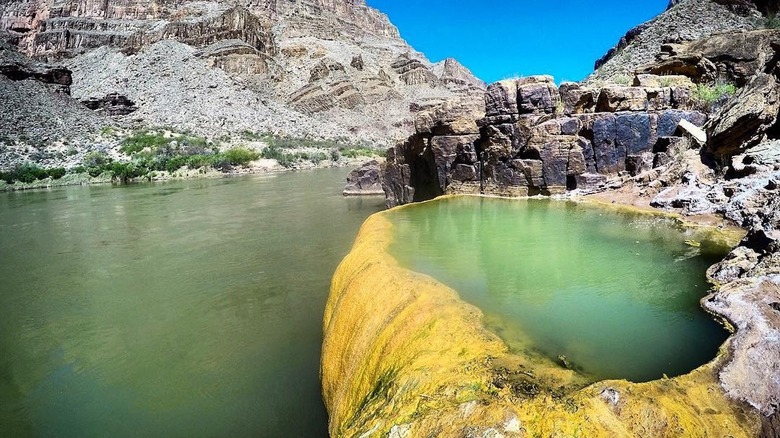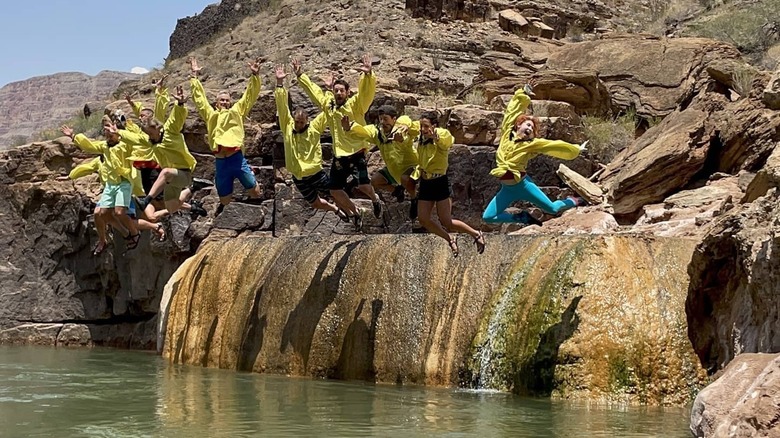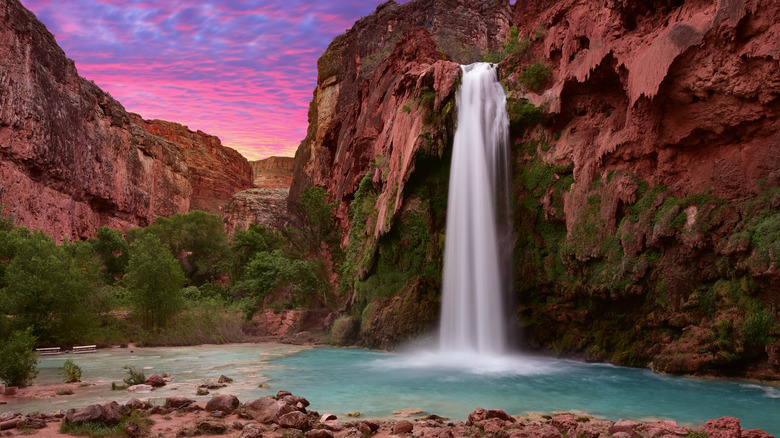This Unusual And Little-Known Arizona Attraction Is Just As Beautiful As It Is Deadly
Among the many fascinating things to see at the bottom of the Grand Canyon, one is just plain weird: a giant rock cauldron that looks like the lower three-quarters of a pumpkin, filled with green water and perched on the edge of the Colorado River. Even weirder, the thing glows bright orange in the sun. While it may seem straight out of a sci-fi movie, this vegetable-like monstrosity is real, located in the Colorado River at mile 212.9. It's called Pumpkin Spring.
The geology behind the strangeness is fascinating. The rock basin's rounded edges and striations give it the shape and texture of a pumpkin, and it collects the greenish mineral water from underground geothermal springs. With its inviting warm water, little rock shelves on which to place cold beverages, and stunning canyon views, Pumpkin Spring may seem like a sweet place for a bath. But please, don't even dip your toe in this freaky pool. It's said that one liter of liquid from the spring contains a whopping 1,100 milligrams of arsenic, which is extremely toxic.
Experiencing Pumpkin Spring
Getting splashed with a little of the water won't kill you, but soaking in this death spa is a really bad idea (as is drinking it, for obvious reasons). That said, Pumpkin Spring is definitely worth a stop when rafting the Grand Canyon. In fact, you can't get to the spring any other way, as it's in a remote section of the canyon.
The ginormous pumpkin is an impressive sight from the water, but climbing up to it to get a closer look is even more fascinating. Check out the murky brew in the pool and notice how it spills over the sides, leaving a fine coating of minerals that causes coloration reminiscent of a 1970s shag carpet. Gazing down at the Colorado River from the spring, you can also appreciate how the pumpkin is (very) slowly getting taller as the river carves an ever deeper channel into the canyon, as it's done for millions of years. There's one more reason to climb up from the river to see the pool: to launch yourself off its rock ledges into the river. It may not be the world's scariest spot for cliff diving, but it provides a good enough excuse to leap into the cold water after a strenuous day of rafting.
Other wonders at the bottom of the Grand Canyon
Pumpkin Spring is just one of many natural treasures hidden deep in the Grand Canyon. While the wonders are endless down there, here are a few of the most well known. First, there's a section of the Little Colorado River near its confluence with the main Colorado River that is right out of a dream. Blue Spring, a mineral-rich spring, spouts water into this part of the Little Colorado, transforming it into a crazy shade of powder blue, which contrasts brilliantly with the red hues of the canyon. The confluence area is also considered sacred in the Native Hopi, Navajo, and Zuni spiritual traditions. You can access the lower Little Colorado on a rafting trip or via a combination of rough roads and backcountry hiking trails.
Another place in the canyon that defies the imagination is the Havasupai Indian Reservation, set below towering cliffs along Havasu Creek, which feeds into the Colorado River. A limestone aquifer near the reservation produces the bright turquoise water in the creek and spectacular waterfalls, of which Havasu Falls is most famous. Getting a permit to visit this surreal and remote place requires some advance planning, but a trip here can be the outdoor adventure of a lifetime.


